Couscous vs Quinoa: The Difference and Which One is Better?
Couscous and quinoa are healthy options becoming more popular. For this reason many of my clients during my health coaching sessions ask if one is better than the other. Therefore, is couscous vs quinoa, which is better?
Quinoa is better than couscous due to its higher percentage of fiber, protein, B vitamins and minerals. It is a complete protein meaning it provides all nine essential amino acids, couscous does not. It is naturally gluten free while couscous is not. Quinoa has a better glycemic index than couscous.
This article will include a complete comparison of both including a side-by-side nutrient comparison. In addition, I’ll examine their prices, tastes, textures, glycemic index, satiety index, health benefits and if one can substitute for the other.
In addition to coaching clients about them, I’ve purchased, researched and consumed both prior to, during and after writing this article.
The Differences
Many people aren’t familiar with one of the two foods or both. Therefore, a common question asked is, what’s the difference between couscous and quinoa?
Couscous is a pasta produced with semolina wheat flower, while quinoa is the seed from a Chenopodium quinoa plant. Quinoa is not a grain but it is cooked in water and consumed like a grain. Couscous can be steamed or cooked in water and takes slightly longer to cook than white quinoa.
Other differences:
- Couscous comes in an off white to yellowish color. Common quinoa colors are white, red and black.
- Couscous costs less money.
- Quinoa provides a higher percentage of fiber, protein, vitamins and minerals.
- Couscous is lower in calories and total fat.
- Quinoa has a better glycemic index.
- Quinoa is naturally gluten free and couscous is not.
- Quinoa has a nuttier flavor and chewier texture.
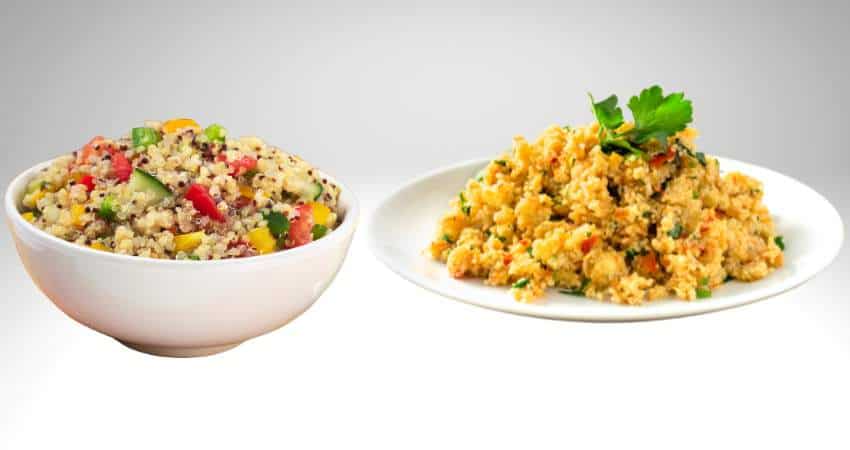
Couscous vs Quinoa: Nutrition Comparison
Both provide many of the same nutrients, although there are some important differences. Different types of each one may vary slightly in their nutrient content.
The following table is a side-by-side comparison of the nutrients contained in 100-grams cooked.
| Couscous (100 g) | Quinoa (100 g) | |
| Calories | 112 | 120 |
| Protein | 3.79 g | 4.40 g |
| Carbohydrates | 23.2 g | 21.3 g |
| Fiber | 1.40 g | 2.8 g |
| Fat | 0.16 g | 1.92 g |
| Sugar | 0.10 g | 0.87 g |
| Vitamin A | 0 IU | 5 IU |
| Beta-carotene | 0 mcg | 0 mcg |
| Vitamin C | 0 mg | 0 mg |
| Vitamin B6 | 0.05 mg | 0.12 mg |
| Vitamin B9 (Folate) | 15 mcg | 42 mcg |
| Vitamin B1 (Thiamin) | 0.06 mg | 0.10 mg |
| Vitamin B2 (Riboflavin) | 0.02 mg | 0.11 mg |
| Vitamin B3 (Niacin) | 0.98 mg | 0.41 mg |
| Vitamin B5 (Pantothenic Acid) | 0.37 mg | 0.33 mg |
| Magnesium | 8 mg | 64 mg |
| Phosphorous | 22 mg | 152 mg |
| Potassium | 58 mg | 172 mg |
| Iron | 0.38 mg | 1.49 mg |
| Copper | 0.04 mg | 0.19 mg |
| Calcium | 8 mg | 17 mg |
| Zinc | 0.26 mg | 1.09 mg |
At first glance it may be difficult to determine which one provides a higher percentage of nutrients than the other. This causes many people to ask, which one is more healthier?
Quinoa is healthier than couscous due to its higher percentage of fiber, protein, vitamins and minerals. It is gluten free, couscous isn’t and quinoa has a better glycemic index than couscous.
Quinoa provides a higher percentage of B6, folate, thiamin, riboflavin, magnesium, phosphorus, potassium, iron, copper, calcium and zinc than couscous.
Couscous provides benefits also and has a higher percentage of niacin, B5 and contains fewer calories, sugar and total fat.
I include both in my daily nutrition plan although I consume quinoa more often. This is due to its higher nutrients and protein.
They both offer healthy nutrients and choosing one may depend on your goals. Let’s examine those in the next section.
Which to Choose?
Some people may alternate between the two or choose one due to their particular goals. Let’s start with what may be the most popular goal.
Weight Loss
If you want to lose extra pounds from the mid-section, you may ask, which is better for weight loss?
Couscous is better for weight loss than quinoa due to its 7% fewer calories per 100 grams cooked. Quinoa contains 120 calories per 100 grams. Couscous contains 112 calories per 100 grams.
Although quinoa has a lower glycemic index and more fiber than couscous it still contains a few more calories. A smaller serving of quinoa would be as beneficial.
Gluten Free
If you have celiac disease or choose to consume a gluten free diet, this can make or break your choice. Between the two foods, which is gluten free?
Quinoa is naturally gluten free while couscous is not gluten free. Therefore, if you require a gluten free diet, quinoa is the better choice.
In addition, it can be made into flour and used as a substitute for regular flour in gluten free recipes.
My Vitamix blender I use at home can make the flour, almond, cashew or any nut flour in seconds. Check out my blender review here, Vitamix Venturist V1220 Review.
The Doctor in the following video compares the health benefits of couscous and quinoa.
Low-carb or Keto Diet
Carbohydrates may be your number one concern if your goal is a Keto or low-carb diet. If you’re on a low-carb diet, you may ask which has more carbohydrates?
Quinoa contains 9% less carbohydrates per 100 grams than couscous making it better for a low-carb diet. Quinoa contains 21.3 grams of carbohydrates per 100 grams cooked. Couscous contains 23.2 grams of carbohydrates per 100 grams cooked.
Another consideration for low-carb diets is the amount of protein. Quinoa provides 4.40 grams of protein per 100 grams.
Bodybuilding
If you’re bodybuilding or just have a goal to gain lean muscle mass, there’s a good chance you’re lifting weights at home or the gym. Which is better for bodybuilding?
Quinoa is better than couscous for bodybuilding due to its higher percentage of protein, vitamins and minerals. Quinoa provides 4.40 grams of protein per 100 grams cooked. Couscous provides 3.79 grams of protein per 100 grams.
This means quinoa provides 16% more protein per 100 grams cooked. The extra amount of protein, vitamins and minerals help to repair and build new muscle after exercise.
It also provides a good amount of carbs. The carbohydrates help to fuel energy and increase exercise performance when lifting weights and exercising.
I often eat quinoa during the morning on the days I train at the gym. The extra carbs help fuel my workout and I’m getting protein at the same time.
Supplements for bodybuilding are expensive, and the costs add up pretty fast. For more details about the prices check out the cost section of this article.
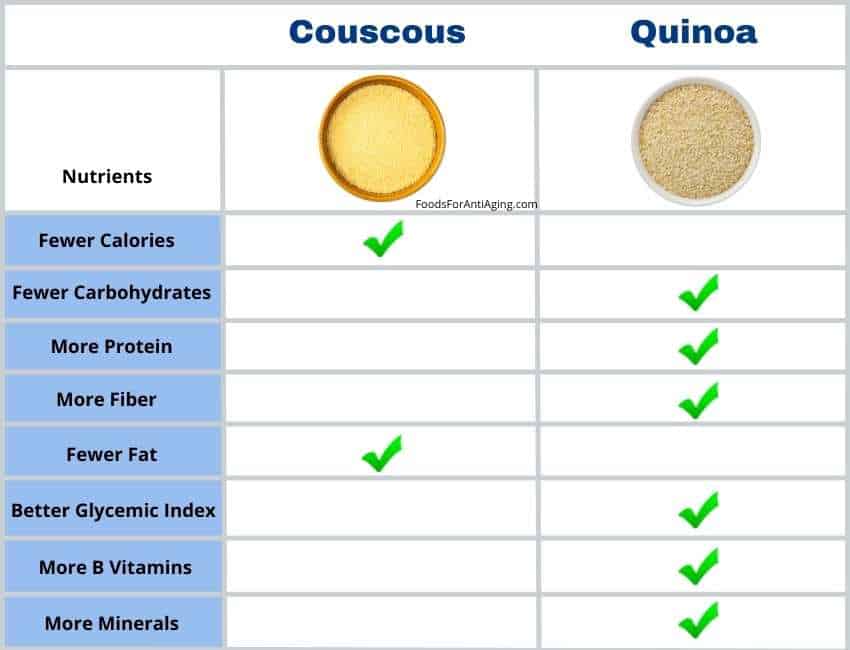
Taste and Texture
Besides the goals and nutrients, many people choose one food over the other because of its taste. Since there are some similarities between the two, many people wonder and ask, do they taste the same?
Both couscous and quinoa have a delicate flavor. Quinoa’s taste is nuttier than couscous which is more pasta like. The red or black varieties are sweeter than the white quinoa or couscous. The white variety is light and fluffy but crunchier than couscous. Red, white and black are chewier than couscous.
Quinoa has a mild flavor and is unsweet and not bitter. It has a slightly nutty flavor, and its texture is fluffy and chewy. When it isn’t rinsed or pre rinsed prior to cooking, it may taste bitter. Red and black is chewier than the white color.
Couscous has a mild, neutral flavor and some people may taste a hint of nutty flavor. Cooked correctly it has a smoother texture and isn’t chewy.
To conduct some original research and get the opinions of real people like you, I decided to poll my clients, readers and people in food groups I belong to. I asked them, which one tasted better?
- 45% said they preferred the taste of quinoa.
- 40% said they preferred the taste of couscous.
- 15% said they had no preference or haven’t tasted one of the two.
To conduct more research I setup and participated in a taste test at home. Two out go three chose the quinoa.
Cooking Differences
Cooked Couscous
If desired, toast couscous with 1 tablespoon of oil for 3 to 5 minutes over medium heat prior to cooking.
- Bring 1 1/2 cups of water to a boil in a pot.
- Add 1 cup of couscous and 1/2 teaspoon of salt and return to a boil.
- Reduce heat to a simmer, cover and continue cooking until tender. About 15 minutes.
- Drain off water and serve.
- Makes 3 servings.
Cooked Quinoa
Most store bought is pre-rinsed, if it is not pre-rinsed it should be rinsed to avoid a bitter taste.
- In a pot combine 1 cup with 2 cups of water or broth.
- Bring to a rolling boil.
- Reduce heat, cover and simmer until liquid is evaporated (about 10-15 minutes).
- Let stand 5 minutes then fluff with a fork and serve.
- Salt or add spices to taste.
Check out 13 healthy substitutes in my article, Quinoa Replacements: 13 Healthy Substitutes.
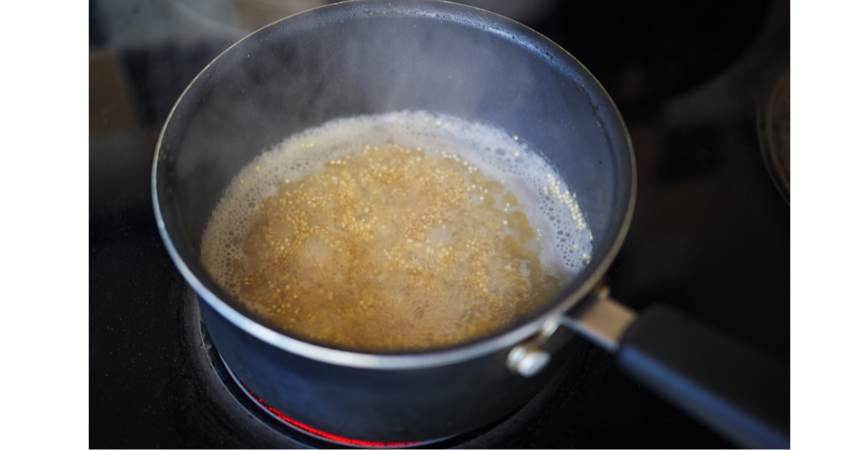
Substituting for Couscous or Quinoa
When someone buys either one, a common question asked, can one substitute for the other?
Quinoa can substitute for couscous and both are interchangeable with each other in recipes, side dishes and salad. Substituting for couscous can make a recipe gluten free depending on the remaining ingredients. Couscous cannot substitute in gluten free dishes because its not gluten free.
When substituting either one use equal amounts called for in the recipe. Couscous takes longer to cook which may change the cooking time of the recipe. Quinoa will make the dish more chewier due to its texture.
The best substitutes for quinoa are:
- Rice
- Millet
- Barley
- Couscous
- Bulgur
- Lentils
- Amaranth
- Buckwheat
The best substitutes for couscous are:
- Quinoa
- Farro
- Buckwheat
- Short grain rice
- Millet
- Riced cauliflower
- Sorghum
- Amaranth
Find out how lentils compared in my article and if it is better.
The following video informs you how to cook couscous.
Which Costs More?
The prices at the supermarket seem to go up weekly. The cost of food certainly matters to most people, especially with the rising costs of everything else.
Therefore, the price may sway your decision about which one to use more often. Let’s examine, which costs more?
Quinoa costs more per serving than couscous. The average price for quinoa is $0.57 per 1/4 cup. The average price for couscous is $0.44 per 1/3 cup.
The prices for both foods vary depending on the store, location and sales offered.
Therefore, to conduct some original research, I searched various different stores to compare the price of both foods.
I first visited the Shoprite supermarket:
- Wholesome Pantry White Quinoa
- $3.99 per 12 oz bag (7 servings) equaling $0.57 per 1/4 cup serving.
- Wholesome Pantry Tri-Color (White, Red, Black)
- $3.99 per 12 oz bag (7 servings) equaling $0.57 per 1/4 cup serving.
- Bob’s Red Mill Pearl Couscous
- $3.99 per 16 oz bag (9 servings) equaling $0.44 per 1/3 cup serving.
I then checked Walmart:
- Food to Live White Quinoa
- $10.99 per 1 pound bag
- Food to Live Organic Red Quinoa
- $13.48 per 1 pound bag
- Bob’s Red Mill Pearl Couscous
- $6.33 per 1 pound bag
- Bob’s Red Mill Golden Couscous
- $8.15 per 1.5 pound bag
Glycemic Index of Couscous and Quinoa
Avoiding blood sugar spikes is an important part of consuming healthy food. This is true for diabetics or anyone worrying about their health3. For this reason, the glycemic index of food is important.
The Glycemic Index (GI) is a scale measuring how fast a particular food raises the blood sugar in the blood. Blood sugar spikes can lead to health complications with the heart, nerves, kidneys and eyes4.
Foods on the GI scale are categorized as:
- Low-GI foods: 55 or under
- Medium-GI foods: 56-69
- High-GI foods: 70 or over
How blood sugars levels are affected:
- Foods with a glycemic index 70 or more cause a quicker spike in blood sugar levels.
- Foods with a glycemic index 56 to 69 cause a moderate spike in blood sugar levels.
- Foods with a glycemic index 55 or less cause a slow spike in blood sugar levels.
Knowing more about the glycemic index of food and how it raises blood sugar, many people ask, which one has a better glycemic index?
Quinoa has a better glycemic index than couscous making it more desirable for diabetics. Quinoa is a low GI food and couscous is a low to medium GI food.
- Couscous boiled for 5 minutes has a glycemic index of 70.
- Red quinoa cooked in boiling water for 15 minutes has a glycemic index of 54.
- White quinoa cooked in boiling water for 15 minutes has a glycemic index of 50.
Find out how these two quinoa types compared to each other in my article.
Satiety Index
Satiety is a term used to explain the feeling of being full and the loss of appetite which occurs after eating food. The satiety index is a scale showing how full a person feels after eating a certain food.
The satiety index was developed in 1995 from a study which tested 38 foods. The foods were ranked how they satisfied a person’s hunger. Foods scoring under 100 are considered less filling and foods scoring above 100 are considered more filling ((National Center for Biotechnology Information: A satiety index of common foods)).
The table below shows the satiety scores of some filling foods.
| Food | Satiety Index Score |
| White bread | 100% |
| Brown rice | 132% |
| White rice | 138% |
| Lentils | 133% |
| Wholemeal Bread | 157% |
| Brown pasta | 188% |
| Oatmeal w/milk | 209% |
In the study, either of the two was not one of the 38 foods tested. I researched scientific studies and found a few which tested the satiety of each one.
A study published in 2018 compared the satiety of couscous and buckwheat. The researchers found both of them reduced the participants appetite over a two-hour period, although they both were equally effective5.
A study in 2005, by the University of Milan, tested the satiety of quinoa, oats and buckwheat compared to eating rice. All three had a higher satiating efficiency than rice6.
Since rice has satiety scores of 132% and 138%, we may be able to assume quinoa and couscous has a higher satiety score than 138%.
High satiety foods are likely to have a high satiety score for the following reasons:
- High in protein.
- High in fiber.
- High in volume (foods containing a lot of water or air).
- Low in energy density (foods low in calories for their weight).
Quinoa provides more fiber and protein which may result in a better satiety.
Find out how these two quinoa varieties compared in my article.
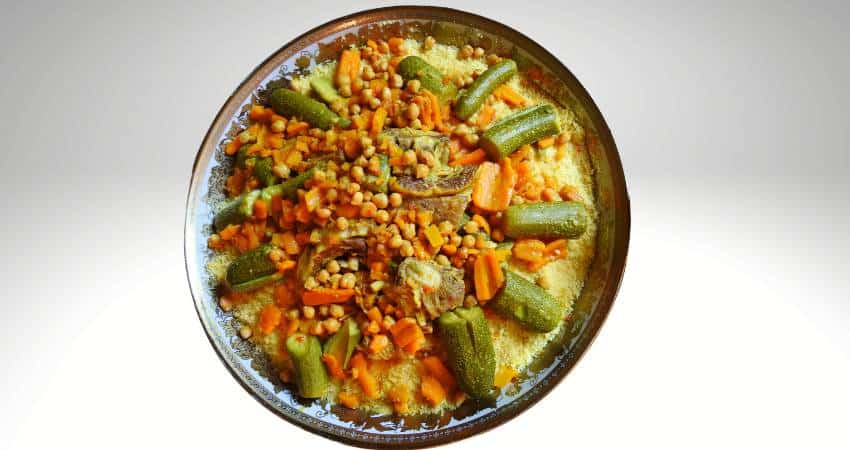
Health Benefits of Couscous and Quinoa
The nutrients in both foods are similar just in different percentages. Therefore, the benefits contained in both are similar but also in different degrees of effectiveness. The following describes how each nutrient may benefit health and which food provides the greater percentage.
Minerals
Quinoa wins in this category and has a significantly higher percentage of every mineral listed in the table above. Let’s take a closer look at some of these minerals and how they benefit health.
Magnesium
Magnesium helps keep blood pressure levels stable and balanced. Recent scientific research examined previous studies and concluded magnesium supplementation decreased systolic and diastolic blood pressure7.
Magnesium helps control the following:
- Blood pressure
- Nerve function
- Blood sugar
- Insomnia
- Muscle
In the heart and muscles, magnesium competes with calcium to help the muscles relax after contracting. When the body is low in magnesium, calcium can over stimulate the heart muscle’s cells causing a rapid or irregular heartbeat8.
One reason many people supplement with magnesium in the evening is because it helps calm the whole body including blood vessels.
Potassium
Potassium helps the body get rid of excess sodium reducing fluid build-up. These help keep systolic and diastolic blood pressure lower ((American Heart Association: How Potassium Can Help Control High Blood Pressure)).
Some medical experts recommend the potassium to sodium ratio of 4:1. Consuming too much sodium or not enough potassium throws off the delicate balance the kidneys need to remove the excess water9.
According to Harvard Health, a number of studies have shown a connection between low potassium levels and high blood pressure10. The more potassium, the more sodium your body will lose.
Iron
Iron is essential in the creation of red blood cells and is a necessary part of any healthy diet. Iron is also vital for growth and development, as some hormones need iron to be appropriately balanced11.
Calcium
Calcium is important for the heart and blood pressure. Harvard Health reports calcium helps maintain blood pressure by helping in the controlling of the relaxing and tightening of blood vessels12.
Calcium also helps the following:
- Help the muscles to function properly.
- Maintain and build strong bones.
- Helps nerve function.
Phosphorus
Phosphorus has been shown in scientific studies to help with the following:
- Promote healthy nerve conduction.
- Promote bone and teeth health.
- Help the kidneys remove waste.
- Muscle contraction and recovery.
- Help the body manage and store energy.
Find out how bulgur compared in my article and find out if it is considered better.
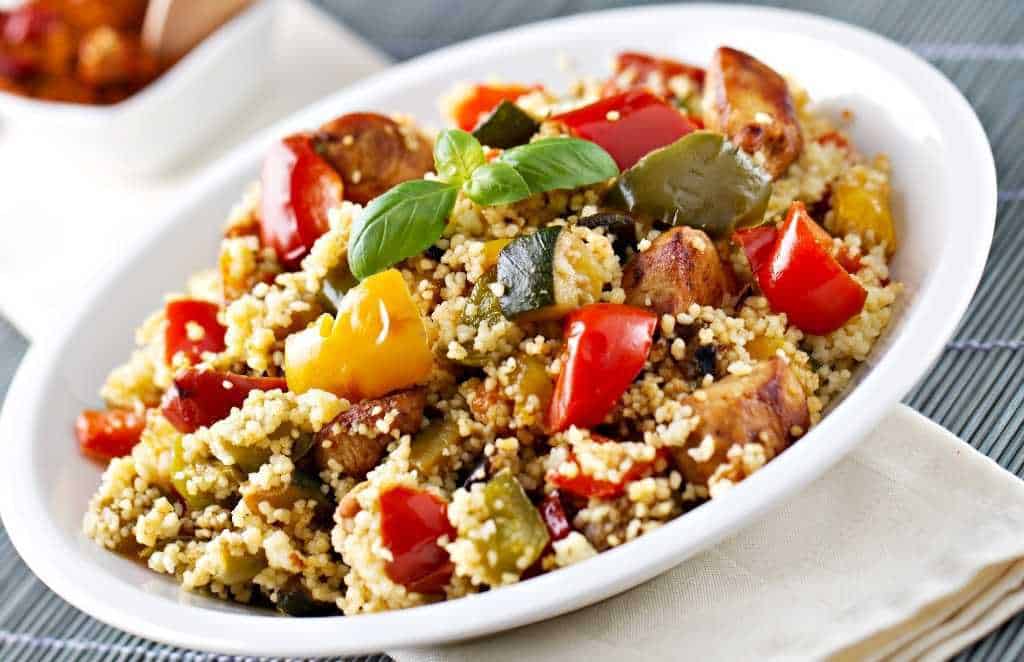
Protein & Dietary Fiber
Fiber
Soluble fiber is helpful for many reasons ((National Center for Biotechnology Information, NIM NIH: Mechanisms linking dietary fiber, gut microbiota and colon cancer prevention)). What makes fiber soluble is it dissolves in water.
Soluble fiber is known for the following:
- Manage the blood glucose levels which helps decrease the risk of diabetes.
- Aids greatly in weight management because it allows you to feel full faster and eat less.
- Help overall digestive health.
- Helps avoid constipation and have a more regular stool.
Protein
Both foods are a good source of protein. Protein may help benefit the following:
- Reduce appetite
- Build and repair muscle
- Boost metabolism
- Weight loss
As noted earlier in the nutrition section of the article, quinoa is a complete protein, contains all the essential amino acids and 16% more protein.
Vitamin Health Benefits
B Vitamins
Quinoa provides a higher percentage of four of the six B vitamins listed below. The B vitamins provided include the following:
- B1 (thiamin)
- B2 (riboflavin)
- B3 (niacin)
- B5
- B6
- B9 (folate)
B vitamins help support the following:
- Brain function.
- Red blood cells.
- Nerve function.
- Cardiovascular disease.
- Energy levels.
- Digestion.
A lack of B vitamins has been associated with oxidative stress and neural inflammation.
In a study released in 2018 32 healthy adults were given B vitamin supplementation for six months. The results indicated preliminary evidence B vitamin supplementation reduced oxidative stress and inflammation13.
The health coach in the following video compares quinoa to couscous.
If you have any questions about this article don’t hesitate to email us. You can find an email on our contact page.
Read Next – More Quinoa Food Articles!
Couscous vs Rice vs Quinoa: Which is Better? Let’s Compare
Brown Rice vs Quinoa: Which is Better? A Complete Comparison
Barley vs Quinoa: Which is Better? A Complete Comparison
Millet vs Quinoa: Which is Better? A Complete Comparison
Quinoa Vs Oatmeal: Which is Better? Let’s Compare
- USDA: Couscous, cooked [↩]
- USDA: Quinoa, cooked [↩]
- The University of Sydney: Your GI Shopping Guide [↩]
- National Institute of Diabetes and Digestive and Kidney Diseases: Know Your Blood Sugar Numbers: Use Them to Manage Your Diabetes [↩]
- Wiley Online Library: The effect of buckwheat and couscous on satiety and short-term food intake in young males [↩]
- Pub Med: Effect on appetite control of minor cereal and pseudo cereal products [↩]
- National Center for Biotechnology Information: Effect of magnesium supplementation on blood pressure: a meta-analysis [↩]
- National Institutes of Health: Magnesium [↩]
- National Center for Biotechnology Information: The Effect of the Sodium to Potassium Ratio on Hypertension Prevalence: A Propensity Score Matching Approach [↩]
- Harvard Health: Potassium lowers blood pressure [↩]
- National Institutes of Health: Iron [↩]
- Harvard Health: Key minerals to help control blood pressure [↩]
- National Center for Biotechnology Information, NIH GOV: The Effect of a High-Dose Vitamin B Multivitamin Supplement on the Relationship between Brain Metabolism and Blood Biomarkers of Oxidative Stress: A Randomized Control Trial [↩]
